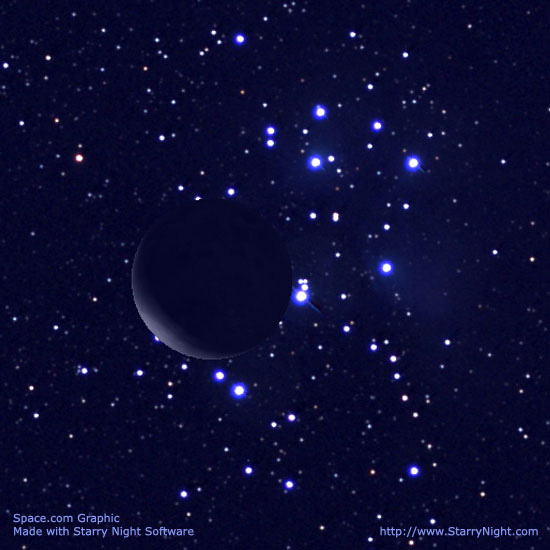
If you live anywhere in the Northeastern United States or the Maritimes of eastern Canada and clear skies are forecast for early on Monday morning, June 30, then be sure to be outside sometime soon after 2:30 a.m. and make a special effort to look for the thin crescent moon hanging very low in the east-northeast sky.
If you have binoculars or a telescope, you will be treated to a very beautiful sight.
The moon will be hanging just above the horizon like an eerily illuminated ball. Indeed, if the sky is very clear and transparent you should readily see the full globe of the moon, with its darkened portion glowing with a bluish-gray hue interposed between the slender sunlit crescent and not much darker sky. This vision is sometimes called "the old moon in the young moon's arms." Leonardo da Vinci (1452-1519) was the first to recognize it as earthshine. That faint bluish-gray light is light from the Earth reflected back to the moon. The Earth's light of course is reflected sunlight, so earthshine is really sunlight which is reflected off Earth to the moon and reflected back to Earth.
Such an earth-lit crescent is always a gorgeous sight, but on June 30 it will have as a backdrop a beautiful array of stars of varying brightness scattered around it. For on that morning, the moon, less than 3 days shy of new phase and only 11 percent illuminated, will be crossing directly in front of the famous Pleiades star cluster. This event is called an occultation, from the Latin occultatio, a hiding, or an "eclipse" of a star or planet. Put another way, when one celestial body — the moon — passes in front of and obscures another, in this case, the Pleiades.
For about an hour the moon will slowly cover and uncover a number of the "Pleiads." The brightest stars of the cluster will mimic tiny blue gems, disappearing along the bright lunar crescent, then they will later reappear from behind the moon's dark limb in dramatic fashion: appearing to suddenly "pop-on" as if someone threw a switch. The overall view may appear strikingly three-dimensional.
In the viewing zone
For those living across New England and eastern New York State, the occultation will already be in progress as the moon rises and will also be at a rather low altitude. Therefore, a clear and unobstructed view toward the east-northeast is strongly recommended.
Prospective viewers in this region will probably have to wait at least a half an hour after the moon rises, for it to lift sufficiently up above the haze that normally hangs close to the horizon to get a good view. Generally speaking, from about 3:00 to 4:00 a.m. will provide the best overall scene. As the moon slowly climbs higher in the east-northeast sky, it will gradually uncover more and more of the cluster. Meanwhile, the eastern sky will be slowly brightening with the advance of morning twilight.
Breaking space news, the latest updates on rocket launches, skywatching events and more!
From the Canadian Maritimes, viewers will have a good view of the moon moving into the Pleiades, but morning twilight will brighten the sky before the moon is completely clear of the cluster. As a result, the reappearance of some stars may not be visible because the sky will be too bright.
Out of the viewing zone
On the other hand, the rest of the US and Canada will miss out on the occultation, as the moon will have already moved past the Pleiades by the time it rises. Nonetheless, the view in binoculars of the crescent moon sitting just below and to the left of the Pleiades cluster as they come up over the east-northeast horizon should still make for a very pretty sight.
Joe Rao serves as an instructor and guest lecturer at New York's Hayden Planetarium. He writes about astronomy for The New York Times and other publications, and he is also an on-camera meteorologist for News 12 Westchester, New York.

Joe Rao is Space.com's skywatching columnist, as well as a veteran meteorologist and eclipse chaser who also serves as an instructor and guest lecturer at New York's Hayden Planetarium. He writes about astronomy for Natural History magazine, Sky & Telescope and other publications. Joe is an 8-time Emmy-nominated meteorologist who served the Putnam Valley region of New York for over 21 years. You can find him on Twitter and YouTube tracking lunar and solar eclipses, meteor showers and more. To find out Joe's latest project, visit him on Twitter.
